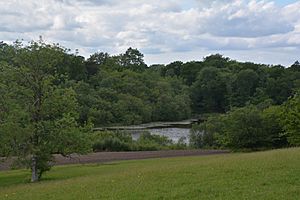Highclere Park facts for kids
| Site of Special Scientific Interest | |
 |
|
| Area of Search | Hampshire |
|---|---|
| Interest | Biological |
| Area | 69.6 hectares (172 acres) |
| Notification | 1991 |
| Location map | Magic Map |
Highclere Park is a special nature area in Hampshire, England. It covers about 69.6 hectares (that's like 172 acres!). This park is officially known as a Site of Special Scientific Interest (SSSI) because of its important plants and animals.
The park is part of the famous Highclere Castle estate. It's also listed as a Grade 1 historic park, meaning it's one of the most important historic gardens in England.
Contents
What Makes Highclere Park Special?
Highclere Park has a very long history. It was first mentioned in records way back in the year 749! This makes it the oldest known estate in Hampshire. Around 1770, a famous landscape designer named Capability Brown helped shape the park into what we see today.
Ancient Trees and Tiny Plants
The park is home to many old, tall trees. These trees are covered in different kinds of lichen and moss. These tiny plants are very important because they show that the woodland here is very old and healthy. Many of the species found here are typical of ancient forests.
Lakes and Watery Habitats
Highclere Park also has two beautiful lakes. Long ago, these lakes were actually fishponds used by the Bishop of Winchester. Today, the edges of these lakes have areas of swamp and fen. These are wet, marshy places that provide homes for many different creatures.
Grasslands and Insects
Besides the trees and lakes, there are also open grassy areas in the park. These grasslands are buzzing with life! Highclere Park is especially known for its many different kinds of invertebrates. Invertebrates are animals without backbones, like insects, spiders, and worms. They play a huge role in the park's ecosystem.

